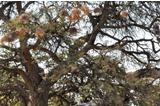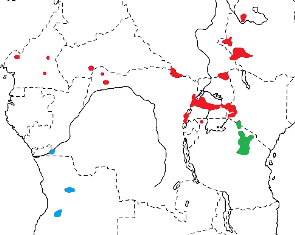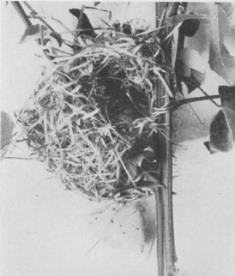Weaver species
Choose different species from drop-down list and press 'Go' button. See Full species list.Black Bishop Euplectes gierowii
IUCN: Least concern Discovery: 076Categories: red bishops,
News items about species
Discovery
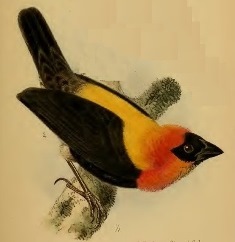
figure from Cabanis (1880) 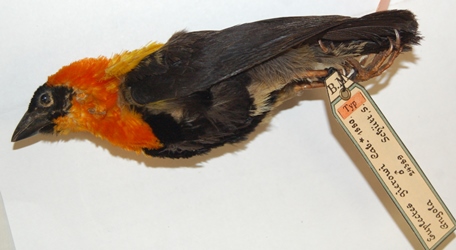
photo of type specimen 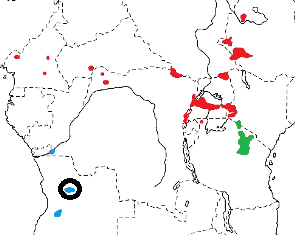
distribution, type locality circled IntroductionThe Black Bishop was formally described by Jean Louis Cabanis, a German ornithologist and director of the Berlin University Museum, who described several other weavers.The Black Bishop was collected by Otto Schutt, a German railway engineer who worked in various countries, being in Angola in 1878-1879, where he collected many birds. Paul Gierow accompanied Schutt on his travels, and Cabanis named the bishop after Gierow, as Cabanis had already named other bird species after Schutt (eg. Black-billed Turaco Tauraco schuetti). Bocage (1893) restricted the type locality from Angola to Cuango River, Malanje Province. This was not based on ornithological publications or from label data, but Bocage drew on his regional knowledge and possible routes taken by Schutt. Schutt wrote a book on his travels in Angola (Reisen Im Sudwestlichen Becken Des Congo). The first illustration of the Black Bishop was published in Cabanis (1880). The second illustration was published by Fischer (1884), of subspecies friederichseni (see Biology of the Black Bishop). Scientific citationEuplectes Gierowii Cabanis 1880 Ornithologisches Centralblatt, 5(1), p. 6, Angola.Meaning of namesgierowii, After Paul Gierow.First English nameAnsorge's Bishop-bird (Shelley 1905).Alternate namesAngola Black-Bishop, Ansorge's Bishop-bird, Gierow's Bishop-bird, Massailand Bishop, Northern Black-Bishop, Southern Black-Bishop.CollectorOtto Schutt and Paul Gierow.Date collected1878 or 1879.Locality collectedCuango River, Malanje Province, Angola.Type specimensThe type specimen is in the Berlin Museum (ZMB 24389). |
The above is based on Weaver Wednesday 2, a weekly series about the discovery of each weaver species.
This species text first appeared as
Weaver Wednesday [193] - Discovery [76]: Black Bishop on 2016-02-24
1. Basic biology
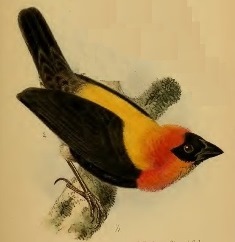
figure from Cabanis 1880 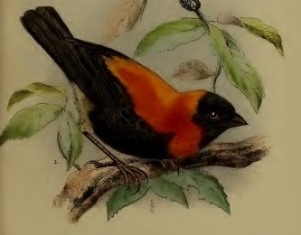
figure from Fischer 1884 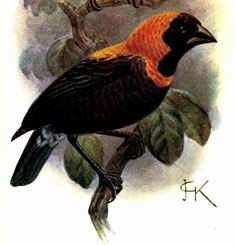
figure from Hartert 1899
Distribution.
The Black Bishop is found in widely separated populations which form 3 subspecies (see map below, based on Birds of Africa):
Habitat. The Black Bishop inhabits tall grassland, in swampy or drier bushy areas, and also scrub and sugar cane. In Kenya it is found in areas with more than 1000 mm annual rainfall, whereas in Tanzania it occurs in drier country. It is often found with the Black-winged Bishop in East Africa. Food. The diet of the Black Bishop includes seeds and insects, the latter including winged ants and alate termites. It forages mainly in pairs and small groups, and joins mixed species flocks in the non-breeding season. Breeding. The Black Bishop is polygynous, and the male holds a territory containing three or four nests. The nest is coarsely woven, with a large entrance high on one side. It is built with grass, and lined with grass seedheads. The nest is usually placed above the above ground in elephant grass, attached to one vertical stalk and some leaf blades, although one nest was in the fork of a shrub. The clutch is 2-4 eggs, and the eggs are bright blue, sometimes with fine black or red-brown spotting. Nothing else is known about its breeding habits. |
The above is based on Weaver Wednesday, a weekly series about weaver species.
This species text first appeared as
Weaver Wednesday [61]: Black Bishop on 2013-08-14
2. Breeding facts
| Pair bond Polygynous Breeding season May-Aug in NE DRCongo, Apr-Oct and Dec in Uganda, May in Kenya, and Apr-Jun and Dec in Tanzania Nest site in Uganda 2 m above ground in elephant grass, attached to one vertical stalk and some leaf blades, one nest in Tanzania was 1 m above ground in fork of wood shrub Nest building No information Colony size male holding territory holding three or four nests Clutch size 2-4 eggs Egg colour bright blue, sometimes with fine black or red-brown spotting Egg size size 20.6 x 15.3 mm Incubation No information Chicks and nestling period No information |
Breeding information based on Handbook of the Birds of the World, Vol. 15.
3. Photos of Weaver Nests
 Vm 9572 |  Vm 9286 |
Thumb-nails of most recent PHOWN records - click on one to see its full record
See all PHOWN records for this species here.
PHOWN (Photos of Weaver Nests) provides valuable info on breeding distribution and colony sizes of weavers.
You can contribute by registering and submitting photos at Virtual Museum webpage.
4. Breeding distribution
Google map showing distribution (For species with small ranges you need to zoom in at the correct area to see the range):
yellow blob - range of weaver species; read more about this here.
![]() - PHOWN records with photos
- PHOWN records with photos
![]() - PHOWN records with no photos (Nest Record Cards, other records)
- PHOWN records with no photos (Nest Record Cards, other records)
![]() - Birdpix records
- Birdpix records
![]() - comments on out of range records, or interesting records
- comments on out of range records, or interesting records
![]() - type locality
- type locality
CLICK on the marker on the map to see individual record details.
5. Range changes
Not South African speciesThe above is based on Weaver Wednesday 3, a weekly series about range changes in South African weaver species.
This species text first appeared as
n/a








